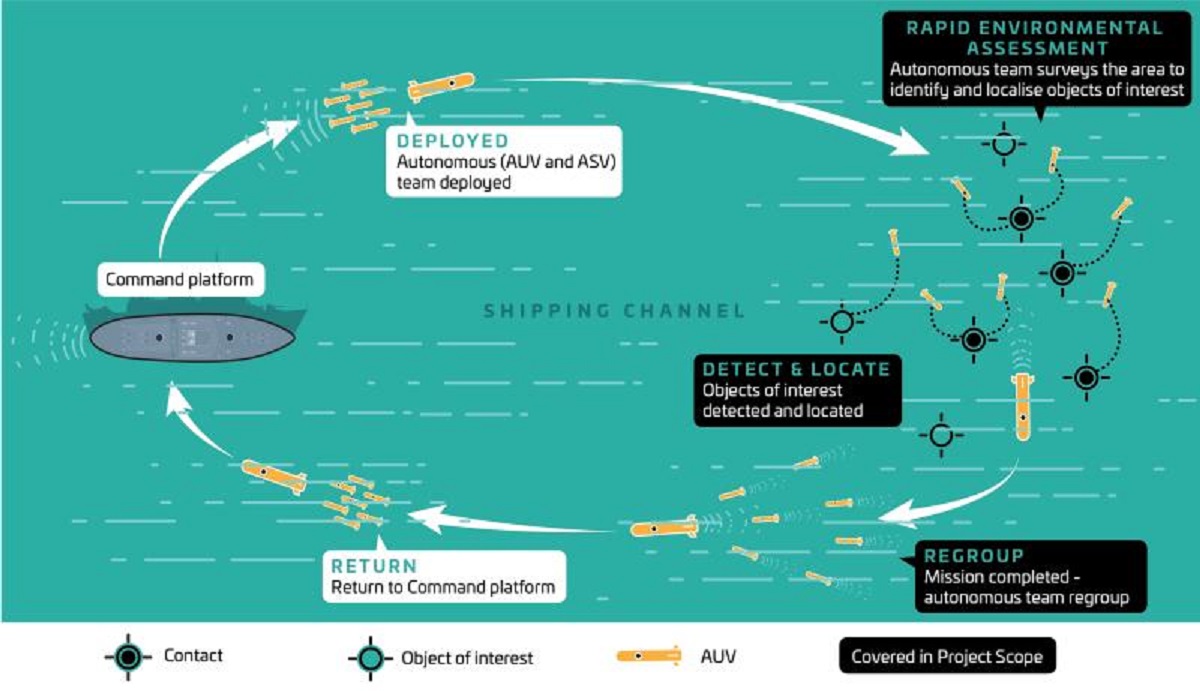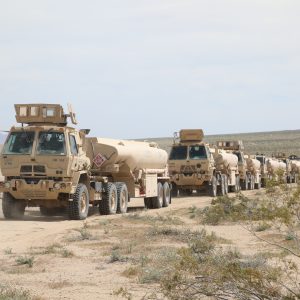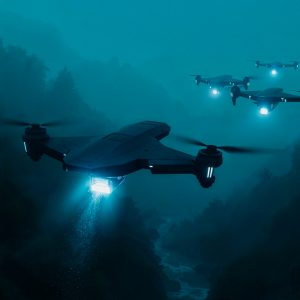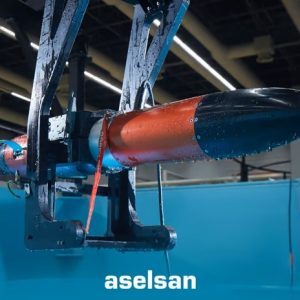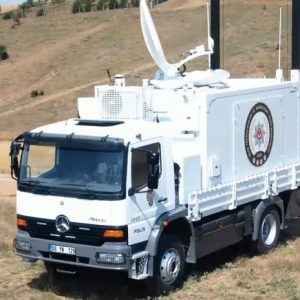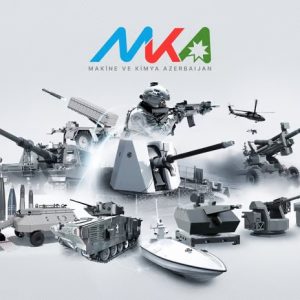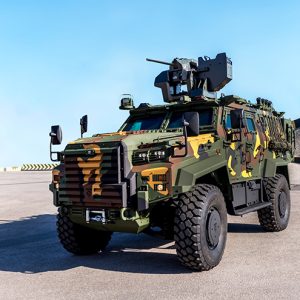Micro‑autonomous underwater vehicles (micro‑AUVs) are quietly becoming a disruptive enabler in naval mine countermeasure (MCM) operations, promising lower cost, enhanced agility and distributed sensing. Recent contract notices and prototype reveals show emerging momentum — yet mainstream defence press is only just catching up.
Why it matters: mine warfare remains a critical threat to naval access and littoral operations. As traditional clearance assets struggle with scale, micro‑AUVs offer a scalable, lower‑risk complement for detection and neutralisation in contested waters.
Key Facts
| Item | Detail |
|---|---|
| Definition | Micro‑AUVs are small, compact underwater drones, often in the size class below typical medium AUVs, optimised for mine detection, classification or neutralisation |
| Recent prototyping | SEABER unveiled a micro‑AUV designed for MCM missions, including side‑scan sonar and modular payloads |
| Contract signalling | U.S. Program Executive Office Unmanned and Small Combatants (PEO USC) has an active contract notice related to unmanned maritime systems, which may include micro‑UUV components |
| Broader MCM trend | Integration of advanced sensors (e.g., synthetic aperture sonar) into compact platforms; Thales + HII integrating SAMDIS with REMUS 620; NATO purchase of Exail K‑Ster vehicles |
| Coverage | Despite these signals, micro‑AUVs for mine warfare are rarely spotlighted in major defence outlets |
Micro‑AUV MCM
Mine warfare persists as a potent asymmetric threat: sea mines can deny access, constrain maritime chokepoints, disrupt logistics and threaten strategic freedom of manoeuvre. Navies have long relied on large dedicated minehunters, clearance divers, or medium class unmanned vehicles. However, these traditional assets face high cost, limited scalability, and risk in contested environments.
The concept of distributed, smaller unmanned systems has grown in many domains (e.g. drones in air). Under the sea, micro‑AUVs represent the analogous trend: compact, agile, swarming-capable underwater drones capable of performing detection, classification or even neutralisation tasks in shallow or cluttered environments.
These micro‑AUVs can reduce risk to larger platforms, be deployed in numbers, operate as expendables, and fill gaps where larger vehicles cannot reach. But deployment at scale and in naval operations still faces sensor, autonomy, communications, endurance, and integration challenges.
New development
In September 2025, SEABER publicly unveiled a micro‑AUV designed for mine countermeasure missions. The device integrates side‑scan sonar and modular payloads, signalling a concrete push into the micro‑UUV space for MCM tasks. :contentReference[oaicite:3]{index=3}
On the procurement side, a SAM.gov contract notice from PEO USC (Unmanned and Small Combatants) dated within the past week suggests potential buy or prototyping of new unmanned maritime systems, possibly including classes such as micro‑AUVs or related small UUV components.
Meanwhile, wider MCM modernization continues: NATO’s acquisition of Exail’s K‑Ster underwater disposal vehicles in a ~€60 million contract indicates interest in more capable, modular mine disposal systems. Also, firms like Thales are collaborating with HII to integrate advanced sonar (SAMDIS) on UUVs (e.g. REMUS 620) enhancing sensor capabilities that might cascade into smaller platforms.
These parallel signals suggest an ecosystem evolution: from large minehunters to mid‑size unmanned systems and now further down to micro‑scale robotics.
Technical / operational implications
Sensor miniaturisation and performance. Embedding high-fidelity sonar (e.g. synthetic aperture sonar), magnetometers or imaging payloads in small form factor platforms is challenging; sensitivity, resolution, power and noise budgets are tight.
Autonomy and AI. Micro‑AUVs must navigate, avoid obstacles, localise, classify mines and (if applicable) neutralise autonomously or semi-autonomously, often in degraded communications or GNSS-denied underwater environments.
Communications and data link. Underwater communications remain limited; micro‑AUVs may need relay nodes (surface buoys, USVs) or acoustic comms with sufficient robustness to exchange data or tasking.
Swarm coordination. To scale usefulness, micro‑AUVs may operate in coordinated swarms, distributing search coverage, dynamically re-tasking, and pooling sensor data to improve detection probabilities.
Deployment, launch & recovery. Handling of small UUVs from ships, USVs or submerged mother platforms (e.g., AUV docking) demands new architectures. Ease-of-launch, modular payload swapping and recovery are crucial.
Endurance & energy. Power constraints (battery energy, efficiency) limit mission duration, speed, and sensor usage; trade-offs between size and endurance are acute.
Integration into MCM systems. Micro‑AUVs must interface with higher‑level C2, mine clearance chains, and defensive architectures; interoperability with unmanned surface vehicles (USVs) and medium AUVs is required.
Programme / procurement angle
Early entrants in micro‑AUV technology may gain advantage when naval services begin issuing Request for Proposals (RFPs) or other transaction authority (OTA) efforts targeting unmanned maritime systems. Companies already prototyping or demonstrating small UUVs (e.g. SEABER) are well positioned.
Primes or systems integrators may bundle micro‑AUV capabilities as add-on modules to larger MCM systems — e.g., adding a swarm of micro‑UUVs to a USV deployment. Naval modernization programmes (e.g. in Europe, Asia or the U.S.) may begin inserting micro‑AUV elements into future mine warfare roadmaps.
Defence Agenda will monitor contract portals (like SAM.gov, TED, NATO Supplies) and procurement notices for terms like “small UUVs,” “micro‑AUV,” “unmanned mine warfare small vehicles,” and publish alerts in our news hub and innovation / unmanned systems analysis streams.
Risks / alternatives
- Performance vs size trade‑off. Miniaturisation may compromise sonar range, classification accuracy or data rates — reducing real operational value.
- Operational fragility. In harsh underwater environments (currents, seabed complexity, clutter, turbulence), tiny platforms may struggle or fail.
- Logistics and sustainment burden. Deploying and maintaining large numbers of micro‑AUVs may impose new logistic burdens (batteries, repair, calibration).
- Communications limitations. Underwater comms constraints may limit real-time control or data offload, constraining their operational autonomy.
- Alternative systems. Medium AUVs, USVs with towed sensors, or hybrid systems may absorb roles, particularly if micro‑AUVs cannot scale.
- Cost per mine cleared. If micro‑AUVs turn out expensive per mission or less reliable, navies may prefer fewer but higher‑capability platforms.
Implications / Next
Micro‑AUVs may become a critical enabler of distributed, scalable mine warfare — enabling navies to more quickly sweep harbor entrances, coastal zones or confined waterways with lower risk to large assets. If maturity is achieved, they could become standard expendables in tactical MCM fleets.
To prepare, stakeholders (naval labs, primes, robotics firms) should accelerate prototyping, field trials, interoperability testing with USVs and larger systems, and define doctrine for micro‑UUV swarms. National procurement authorities and innovation agencies should issue focused solicitations to spur competition in this class.
Defence Agenda will publish contract alerts, comparative technology deep-dives, and track which navies adopt micro‑AUVs first. For now, this is a technology niche worth watching. See updates via our news hub and autonomy / naval robotics analysis sections.
Further Reading
- Internal: Defence Agenda — News hub: defenceagenda.com/news
- Internal: Defence Agenda — Analysis hub / unmanned systems
- External: SEABER unveils micro‑AUV for MCM missions
- External: U.S. PEO USC contract notice for unmanned maritime systems (possible micro‑UUV RFP)
- External: NATO awards Exail €60 million contract for K‑Ster underwater disposal vehicles
- External: Thales + HII partnership for MCM systems integration

